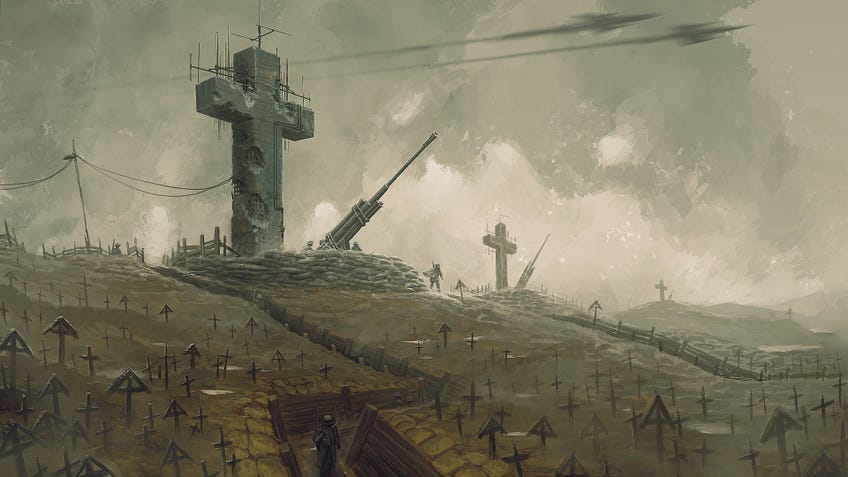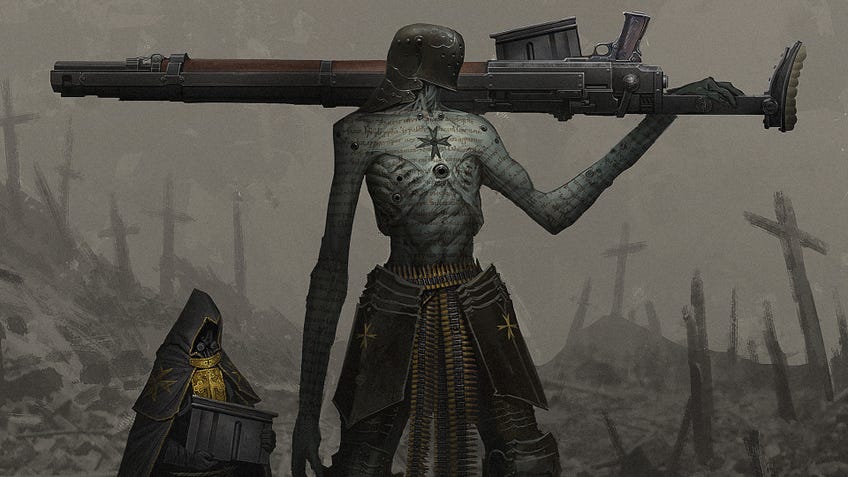Diablo artist's gorgeously grimdark miniatures game is World War I by way of Warhammer 40,000
Mike Franchina's hellish visions come to life in new playtest rules.
Wargames are a pretty big investment. They typically require players to acquire and paint miniatures, read a massive rulebook (or two) and assemble a team - then, convince a friend to repeat this process, commandeer a decently-sized table and a few spare hours (“a few” here depending on how well you convinced your friend to read that rulebook) and get to work. In that case, it’s important that any new wargame has some very big draws to get you in its camp.
Trench Crusade has two. Their names are Tuomas Pirinen and Mike Franchina, a game designer and concept artist duo who are both 20-year veterans of the gaming industry. Pirinen’s resume especially proves relevant here - he was the main creative mind behind Mordheim, Games Workshop’s own miniatures skirmish game, and a huge design force behind Warhammer Fantasy Battle’s sixth edition.
But it’s Franchina’s art, reflecting his work for video games including Diablo IV and Magic: The Gathering’s unsettling Phyrexia: All Will Be One set, that sells the game so well. The eclectic mix of WWI-era combat gear, medieval iconography and hellish abominations comes together in characters like the Communicant Anti-Tank Hunter - a gangly, ten-foot figure with an even taller rifle, a belt of bullets and a silent acolyte devoted to carrying its ammunition - or the Anointed Heavy Infantry, a hulking figure with centurion plumage and ever-burning skin. Trench Crusade was an art project and a world before it was ever a game, and that imagination shines through even in the limited looks we’ve had so far.
As far as actual gameplay, things aren’t set in stone. Trench Crusade just released its playtest rules, but no final rulebook exists yet. Pirinen promises “campaign and exploration rules, supernatural powers, most of the warband lists and scenarios, terrain and miniature painting sections and much, much more” coming in the game’s full release.
What exists in this first iteration is promising to say the least.
What exists in this first iteration is promising to say the least. From the start, Trench Crusade feels highly involved. The suggested 700 ducats is a deep pool from which to build and decorate a band, meaning that Trench Crusade boasts impressive granularity in its builds. Scenarios and terrain offered are varied enough that there’s no one formula for success. In a trench battle replete with cover, the Heretic Legion’s Artillery Witch shines, teleporting volatile bombs on top of enemy infantry lines. In open fields, however, combat can warp as squads of infantry flanking heavy units like the Shrine Anchorite and War Wolf form roving squads that demolish anything in their path.

Scenarios feature Glorious Deeds, small objectives that players compete for (take out an Elite with a given type of weapon, for example) to award Glory Points, a unique currency usable on certain pieces of powerful equipment. I love this inclusion - it incentivises risky play to the detriment of the battle at hand for the sake of long-term power, encourages players to get stuck into the action as quickly as possible to swipe glory away from their opponent and creates a great ludonarrative arc as scores of troopers throw themselves away for the betterment of uncaring and horrifying elite units.
Glory Points incentivise risky play to the detriment of the battle at hand for the sake of long-term power.
It’s clear, then, that while Trench Crusade’s battles are spats of combat, the game is angling towards a war of attrition. Playing into this slogging feel is the Injury table, the game’s primary mechanic for taking damage. As units suffer hits, they accumulate blood markers, representing harm, shellshock, mental strain and the like. The actual effect of this injury is decided by your opponent - they can choose either to consume blood markers to impose a penalty on rolls made by that unit, or spend them when the unit takes damage to increase the severity of injuries.

This contributes to what is probably Trench Crusade’s most rewarding system thus far. All that consuming blood does is expand the pool of dice used for a given roll (similar to advantage and disadvantage in D&D), meaning that using blood too early could prove useless. So the game emerges into this tense push-and-pull - how long can you wait to spend blood markers? If you pile up blood, you risk so many of your units being taken out that you’ll be unable to hit an enemy to spend it all. Do you allow your opponent a free roll on your Elite, or do you spend precious blood markers to protect it from the enemy Infiltrator and risk being unable to take the Infiltrator out for another couple of turns? It’s an innovative take on a damage system that has been refreshingly effective so far at drawing players into the high-strung horror of Trench Crusade’s battles.
While it’s far from finished, Trench Crusade’s playtest rules and established look provide a very promising first glimpse. The game made over $30,000 during its initial 12-day Kickstarter in 2022, and Pirinen says it might be the best set of rules he’s ever written. I can only hope he’s right.


